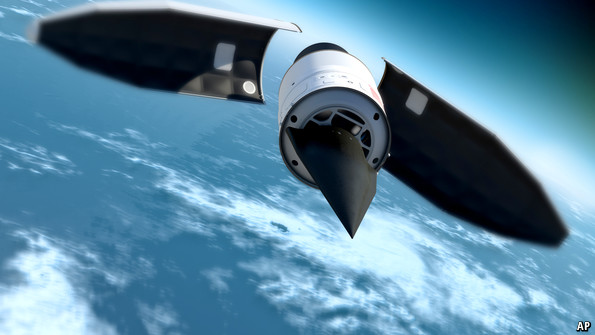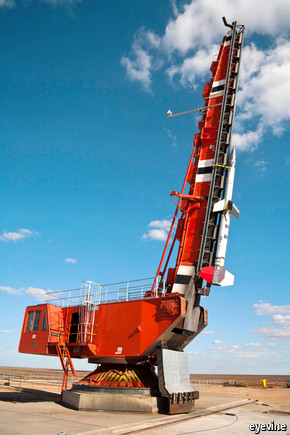Hypersonic weapons: Building vehicles that fly at five times the speed of sound is amazingly hard, but researchers are trying

ON AUGUST 20th 1998 Bill Clinton ordered American warships in the Arabian Sea to fire a volley of more than 60 Tomahawk cruise missiles at suspected terrorist training camps near the town of Khost in eastern Afghanistan. The missiles, flying north at about 880kph (550mph), took two hours to reach their target. Several people were killed, but the main target of the attack, Osama bin Laden, left the area shortly before the missiles struck. American spies located the al-Qaeda leader on two other occasions as he moved around Afghanistan in September 2000. But the United States had no weapons able to reach him fast enough.
After the terrorist attacks of September 11th 2001, American officials decided that they needed to obtain a “prompt global strike” capability, able to deliver conventional explosives anywhere on Earth within an hour or two. One way to do this would be to take existing intercontinental ballistic missiles (ICBMs) and replace the nuclear warheads with standard explosives. The hitch is that ballistic missiles are usually armed with nuclear warheads. A launch could therefore be misconstrued as the start of a nuclear strike, says Arun Prakash, a former Chief of the Naval Staff, the top job in India’s navy.
Moreover, ICBMs carrying conventional explosives towards targets in Asia or the Middle East would at first be indistinguishable from those aimed at China or Russia, according to a paper issued by the Congressional Research Service, an American government-research body. This uncertainty might provoke a full-scale nuclear counterattack. In the years after 2001 funding for non-nuclear ballistic missiles was repeatedly cut by Congress, until military planners eventually gave up on the idea. Instead, they have now pinned their hopes on an alternative approach: superfast or “hypersonic” unmanned vehicles that can strike quickly by flying through the atmosphere, and cannot be mistaken for a nuclear missile.
These hypersonic vehicles are not rockets, as ICBMs are, but work in a fundamentally different way. Rockets carry their own fuel, which includes the oxygen needed for combustion in airless space. This fuel is heavy, making rockets practical only for short, vertical flights into space. So engineers are trying to develop lightweight, “air breathing” hypersonic vehicles that can travel at rocket-like speeds while taking oxygen from the atmosphere, as a jet engine does, rather than having to carry it in the form of fuel oxidants.
The term hypersonic technically refers to speeds faster than five times the speed of sound, or Mach 5, equivalent to around 6,200kph at sea level and 5,300kph at high altitudes (where the colder, thinner air means the speed of sound is lower). Being able to sustain flight in the atmosphere at such speeds would have many benefits. Hypersonic vehicles would not be subject to existing treaties on ballistic-missile arsenals, for one thing. It is easier to manoeuvre in air than it is in space, making it more feasible to dodge interceptors or change trajectory if a target moves. And by cutting the cost of flying into the upper reaches of the atmosphere, the technology could also help reduce the expense of military and civilian access to space.
All this, however, requires a totally different design from the turbofan and turbojet engines that power airliners and fighter jets, few of which can operate beyond speeds of about Mach 2. At higher speeds the jet engines’ assemblies of spinning blades can no longer slow incoming air to the subsonic velocities needed for combustion. Faster propulsion relies instead on engines without moving parts. One type, called a ramjet, slows incoming air to subsonic speeds using a carefully shaped inlet to compress and thereby slow the airstream. Ramjets power France’s new, nuclear-tipped ASMPA missiles. Carried by Rafale and Mirage fighter jets, they are thought to be able to fly for about 500km at Mach 3, or around 3,700kph.
It’s not rocket science
But reaching hypersonic speeds of Mach 5 and above with an
air-breathing engine means getting combustion to happen in a stream of
supersonic air. Engines that do this are called supersonic-combustion
ramjets, or scramjets. They also use a specially shaped inlet to slow
the flow of incoming air, but it does not slow down enough to become
subsonic. This leaves engineers with a big problem: injecting and
igniting fuel in a supersonic airstream is like “lighting a match in a
hurricane and keeping it lit,” says Russell Cummings, a
hypersonic-propulsion expert at California Polytechnic State University.One way to do it is to use fuel injectors that protrude, at an angle, into the supersonic airstream. They generate small shock waves that mix oxygen with fuel as soon as it is injected. This mixture can be ignited using the energy of bigger shock waves entering the combustion chamber. Another approach is being developed at the Australian Defence Force Academy. In a process known as “cascade ionisation”, laser blasts lasting just a few nanoseconds rip electrons off passing molecules, creating pockets of hot plasma in the combustion chamber that serve as sparks.
Scramjet fuel must also be kept away from the wall of the combustion chamber. Otherwise, it might “pre-ignite” before mixing properly, blowing up the vehicle, says Clinton Groth, an engineer at the University of Toronto who is currently doing research at Cambridge University in England (and who has consulted for Pratt & Whitney and Rolls-Royce, two engine-makers). To complicate matters further, scramjets move too fast for their internal temperature and air pressure to be controlled mechanically by adjusting the air intake. Instead, as scramjets accelerate, they must ascend into thinner air at a precise rate to prevent rising heat and pressure from quickening the fuel burn and blowing up the combustion chamber.
In other words, igniting a scramjet is difficult, and keeping it going without exploding is harder still. Moreover scramjets, like ramjets, cannot begin flight on their own power. Because they need to be moving quickly to compress air for combustion, scramjets must first be accelerated by piggybacking on a jet plane or rocket. There are, in short, formidable obstacles to the construction of a scramjet vehicle. Even though the idea has been around since the 1950s, it was not until the 1990s that a scramjet was successfully flight-tested by Russian researchers, working in conjunction with French and American scientists—and some experts doubt that those tests achieved fully supersonic combustion.

HyShot goes supersonic down under
More recently America’s space agency, NASA, has made progress with two experimental scramjet vehicles, both of which are dropped from a carrier plane and then accelerated using a rocket booster. The unmanned, hydrogen-fuelled X-43A scramjet accelerated to a record Mach 9.68 in November 2004. This was the first fully controlled flight of a scramjet-powered vehicle, though it lasted only ten seconds.
NASA is now concentrating on another test vehicle, the X-51A Waverider. In its first test, carried out in May 2010, the X-51A reached Mach 5, but not a hoped-for Mach 6, during a flight lasting roughly 200 seconds. Subsequent tests in June 2011 and August 2012 both failed. In a test flight on May 1st 2013, however, the X-51A maintained a speed of Mach 5.1 for four minutes, in the longest scramjet flight on record.
The unsheltering sky
In 2010 the head of America’s Pacific Command, Admiral Robert
Willard, said that a Chinese programme to convert a nuclear ballistic
missile into an aircraft-carrier killer, by packing it with conventional
explosives, had reached “initial operational capability”. The DF-21D,
as it is called, is designed to descend from space at hypersonic speed
and strike ships in the Western Pacific. Even though the accuracy of the
DF-21D’s guidance system is unknown, the missile is already altering
the balance of power within its range, says Eric McVadon, a consultant
on East Asian security and a former US Navy rear-admiral.
“America is slowly losing the strategic advantage that its stealth warplanes have long provided.”
Having ruled out such systems due to the “nuclear ambiguity” a launch
would cause, and with powered hypersonic vehicles descended from the
X-51A still years away, America has begun testing yet another approach.
As part of an effort called Project Falcon, the US Air Force and DARPA,
the research arm of America’s armed forces, have developed hypersonic
“boost-glide” vehicles that piggyback on a modified ICBM and achieve
hypersonic speeds simply by falling from a high altitude, rather than
using a scramjet.The “hypersonic cruise vehicle” (pictured on previous page), is carried on an ICBM into the lower reaches of space where it separates, and, rather than following an arching ballistic trajectory, glides back to Earth at more than 20,000kph. The first vehicle, tested in April 2010, successfully separated from its ICBM, but about nine minutes later contact was lost. “They were getting good data and then the skin peeled off and it went boom,” says Brian Weeden, a former air-force captain and nuclear-missile launch officer stationed in Montana. A test in 2011 also failed.
In spite of such setbacks, research into hypersonic weapons will continue. Building a vehicle capable of gliding at Mach 16 is difficult, but not impossible. America’s space shuttle used to re-enter the atmosphere at Mach 25, so fast that friction heated air molecules into a layer of plasma around the craft that radio signals could not penetrate. New “ceramic matrix composites” show great heat-shielding promise, says Sankar Sambasivan, the boss of Applied Thin Films, a company in Illinois that makes parts for military aircraft.
Testing equipment is also improving. Heat and pressure sensors, and even video cameras, can be embedded in vehicles to gather data as they fly, providing “a level of detail and fidelity that we’ve never had before,” says Ken Anderson, head of hypersonic air vehicles at Australia’s Defence Science and Technology Organisation. Better wind tunnels help, too. The one at Belgium’s Von Karman Institute for Fluid Dynamics can generate short blasts of air at Mach 14. This is done by cooling the test chamber, reducing the speed of sound and thereby increasing the Mach number of air forced in with a piston.
Last year a DARPA statement noted that America is gradually losing the “strategic advantage” that its stealth warplanes have long provided, as other countries’ stealth and counter-stealth capabilities continue to improve. Instead, DARPA suggested, America will need “the new stealth” of hypersonic vehicles. Similarly, Russia’s deputy prime minister, Dmitry Rogozin, remarked last year that the design of hypersonic missiles had become a priority for the country. Getting anything to work at all under hypersonic conditions is extraordinarily difficult—but the effort continues even so.
No comments:
Post a Comment